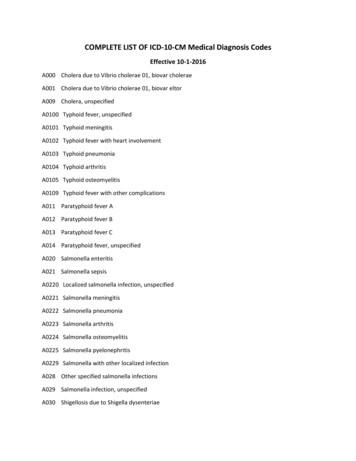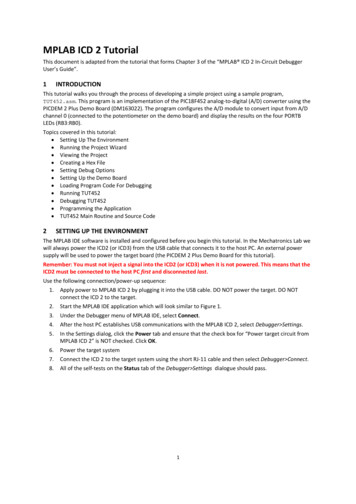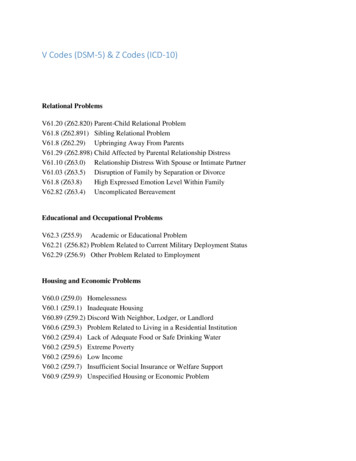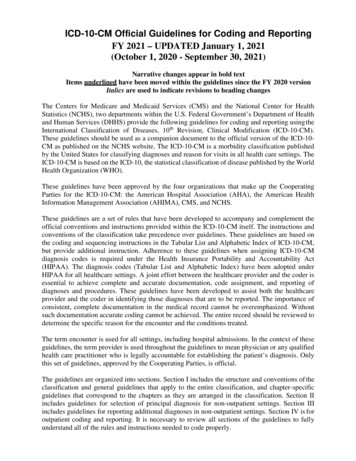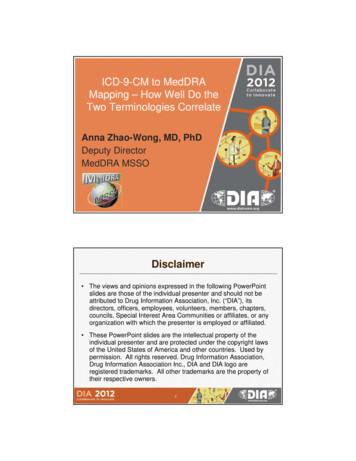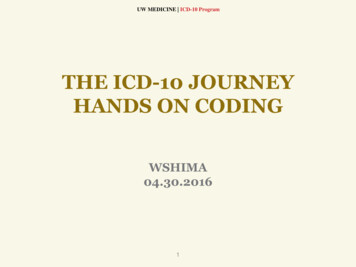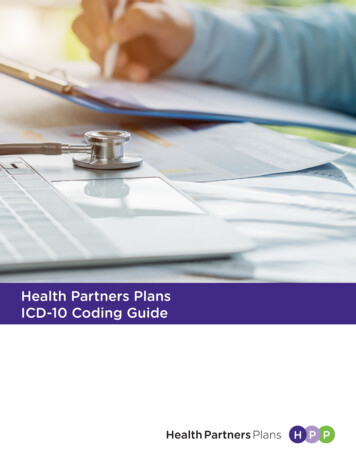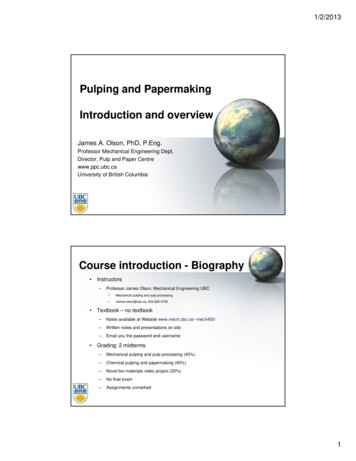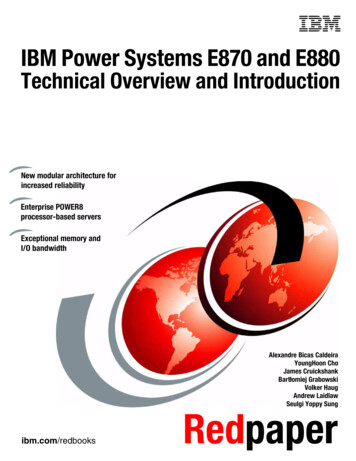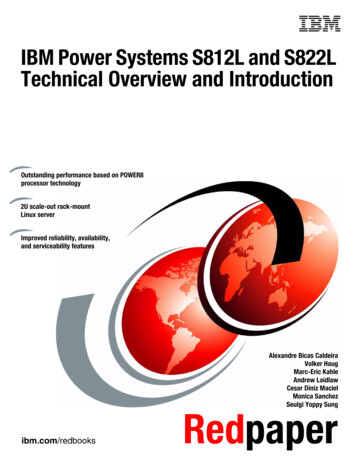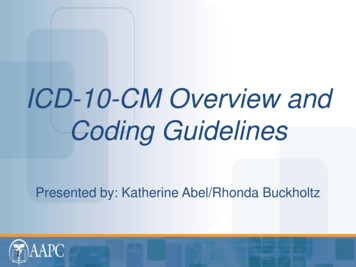
Transcription
ICD-10-CM Overview andCoding GuidelinesPresented by: Katherine Abel/Rhonda Buckholtz1
No part of this presentation maybe reproduced or transmitted inany form or by any means(graphically, electronically, ormechanically, includingphotocopying, recording, or taping)without the expressed writtenpermission of AAPC.2ICD-10-CM Overview and Coding Guidelines2
Introduction The Health Insurance Portability andAccountability Act (HIPAA) of 1996includes provisions for the standardizationof health care ntifiersPrivacyCode SetsICD-10-CM Overview and Coding Guidelines3
ICD-10-CM ICD-10-CM contains significantimprovements– Expanded injury codes– Creation of combination diagnosis symptomcodes– Addition of up to seven-characteralphanumeric subclassifications– Addition of laterality in code assignment4ICD-10-CM Overview and Coding Guidelines4
Final RuleJanuary1, 2012October1, 20145 5010 to be used forelectronic submissions ICD-10-CM to be used forOutpatient Services ICD-10-PCS to be usedfor Inpatient ServicesICD-10-CM Overview and Coding Guidelines5
History of ICD ICD-10 was endorsed by the 43rd WorldHealth Assembly in May 1990– Came into use in 1994– ICD has origins into the 1850’s6ICD-10-CM Overview and Coding Guidelines6
Characteristics of ICD-10-CM Expanded to include health-relatedconditions and to provide greaterspecificity at the 6th character level andwith a 7th character extension Guidance is found in Official Coding andReporting guidelines section of ICD-10CM7ICD-10-CM Overview and Coding Guidelines7
Format and Structure Differences from ICD-9-CM include:––––Some chapters have been rearranged.Some titles have changed.Conditions have been regrouped.ICD-10 has almost twice as manycategories as ICD-9.– Minor changes have been made in thecoding rules for mortality.8ICD-10-CM Overview and Coding Guidelines8
Format and Structure ICD-10-CM consists of:– Tabular lists containing cause-of-death titlesand codes, Inclusion and exclusion termsfor cause-of-death titles, Alphabetical indexto diseases and nature of injury– External causes of injury– Table of drugs and chemicals description,guidelines, and coding rules9ICD-10-CM Overview and Coding Guidelines9
Key Terms 10Combination pal or First-listed diagnosis codeRubricICD-10-CM Overview and Coding Guidelines10
Code Structure All categories are three characters– The first character of a category is a letter. The secondand third characters may be either numbers or alphacharacters. Subcategories are either four or five characters.– Subcategory characters may be either letters ornumbers. Codes are three, four, five, or six characters and the finalcharacter in a code may be either a letter or number. Certain categories have 7th character extensions whichmay be either a letter or a number.11ICD-10-CM Overview and Coding Guidelines11
Three Character Categories Each chapter begins with three charactercategoriesChapter 1 CertainInfectious and ParasiticDiseases (A00–B99) A00–A09 Intestinalinfectious diseases B15–B19 Viralhepatitis12Chapter 2 Neoplasms(C00–D49) C00–C14 Lip, oralcavity and pharynx C51–C58 Femalegenital organsChapter 4 Endocrine,Nutritional andMetabolic Diseases(E00–E90) E08–E14 Diabetesmellitus E65–E68 Obesityand otherhyperalimentationICD-10-CM Overview and Coding Guidelines12
Four Character Categories The four character categories further define thesite, etiology, and manifestation or state of thedisease or condition.Example:–––––C15 Malignant neoplasm of the esophagusC15.3 Malignant neoplasm of upper third of esophagusC15.4 Malignant neoplasm of middle third of esophagusC15.5 Malignant neoplasm of lower third of esophagusC15.8 Malignant neoplasm of overlapping sites ofesophagus– C15.9 Malignant neoplasm of esophagus, unspecified13ICD-10-CM Overview and Coding Guidelines13
Five-Six Character Classification In ICD-10-CM, a 5th or 6th six character subclassifications represents the most accurate levelof specificityExample:– J10.8 Influenza due to other influenza virus with othermanifestations– J10.81 Influenzal gastroenteritis– J10.89 Influenza with other manifestationsInfluenzal encephalopathyInfluenzal myocarditis14ICD-10-CM Overview and Coding Guidelines14
Seventh Character Extension Certain ICD-10-CM categories haveapplicable seven characters– The applicable 7th character is required forall codes within the category, or as thenotes in the Tabular List instruct.– The seventh character must always be the7th character in the data field.15ICD-10-CM Overview and Coding Guidelines15
Seventh Character ExtensionExample:– T50.B96A Underdosing ofother viral vaccines, initialencounter– T50.B96D Underdosing ofother viral vaccines,subsequent encounter– T50.B96S Underdosing ofother viral vaccines, sequela16ICD-10-CM Overview and Coding Guidelines16
Dummy Placeholders ICD-10-CM utilizes a placeholdercharacter “X”– The “X” is used as a 5th characterplaceholder at certain six character codes toallow for future expansion.Example:– T15.12XS Foreign body in conjunctival sac,left eye, sequela17ICD-10-CM Overview and Coding Guidelines17
Locating a CodeLocateCode inIndexVerifyCode inTabularListAssign codesbased oncodingconventions18ICD-10-CM Overview and Coding Guidelines18
ICD-10-CM ConventionsCode First/Use Additional Code Notes– Etiology/manifestation paired codes have aspecific index entry structure.– In the index both conditions are listedtogether with the etiology code first followedby the manifestation codes in brackets.– The code in brackets is always to besequenced second.19ICD-10-CM Overview and Coding Guidelines19
ICD-10-CM ConventionsNECAn alphabetic index entry that states NECdirects the coder to an “other specified”code in the Tabular List.NOS“Not otherwise specified.” Thisabbreviation is the equivalent ofunspecified.20ICD-10-CM Overview and Coding Guidelines20
ICD-10-CM Conventions[ ] Brackets are used in the Tabular List to enclose synonyms, alternativewording, or explanatory wording. Brackets are used in the alphabeticIndex to identify manifestation codes.( ) Parentheses are used in both the Alphabetic Index and Tabular List toenclose supplemental words that do not affect the code number.:Colon is used after an incomplete term that needs one or more of themodifiers that follow to make it assignable to a given category.} The brace encloses a series of terms each of which is modified by thestatement appearing at the right of the brace., Words following a comma are essential modifiers. The term in theinclusion note must be present in the diagnostic statement to qualifythe code.21ICD-10-CM Overview and Coding Guidelines21
ICD-10-CM ConventionsCode Also– A “code also” note instructs that two codes may berequired to fully describe a condition, but thesequencing of the two codes depends on the severityof the conditions and the reason for the encounter.“See” and “See Also”– The “see” instruction following a main term in theIndex indicates that another term should be referenced.22ICD-10-CM Overview and Coding Guidelines22
ICD-10-CM ConventionsExample:Amentia—see also Disability, intellectual—Meynert’s(nonalcoholic) F04Annular—see alsocondition23ICD-10-CM Overview and Coding Guidelines23
Default CodesCode listed next to amain term in theICD-10-CM Index isreferred to as adefault code.24ICD-10-CM Overview and Coding Guidelines24
ICD-10-CM ConventionsCode First/Use Additional Code Notes Codes that have both an underlyingetiology and multiple body systemmanifestations due to the underlyingetiology require sequencing the underlyingcondition first followed by themanifestation.25ICD-10-CM Overview and Coding Guidelines25
ICD-10-CM ConventionsExample:H42 Glaucoma in diseases classifiedelsewhereCode first underlying condition, suchas:–––––26amyloidosis (E85.)aniridia (Q13.1)Lowe’s syndrome (E72.03)Reiger’s anomaly (Q13.81)specified metabolic disorder (E70-E90)ICD-10-CM Overview and Coding Guidelines26
ICD-10-CM ConventionsExcludes notes Two types of excludes notes– Independent of each other. Excludes1– Indicates that the code excluded should never be usedat the same time as the code above the Excludes1note. Excludes2– Indicates that the condition excluded is not part of thecondition represented by the code, but from a patientwho may have both conditions at the same time.27ICD-10-CM Overview and Coding Guidelines27
ICD-10-ConventionsExample:I10 Essential (primary) HypertensionIncludes:High blood pressure hypertension (arterial)(benign) (essential) (malignant) (primary)(systemic)Excludes1: hypertensive diseasecomplicating pregnancy, childbirth and thepuerperium (O10-O11, O13-O16)28ICD-10-CM Overview and Coding Guidelines28
ICD-10-ConventionsEXAMPLE: J03 Acute tonsillitisExcludes2: chronic tonsillitis (J35.0)29ICD-10-CM Overview and Coding Guidelines29
ICD-10-ConventionsInclusion Terms– Lists of terms are included under somecodes. These terms are some of theconditions for which that code number is tobe used.Other specified and NEC– An index entry that states NEC directs thecoder to an “other specified” code in theTabular List30ICD-10-CM Overview and Coding Guidelines30
ICD-10-CM ConventionsUnspecified and NOS The abbreviation NOS, “Not otherwisespecified,” in the Tabular List is theequivalent of “unspecified.”31ICD-10-CM Overview and Coding Guidelines31
ICD-10-CM ConventionsExample:A04.9 Bacterial intestinalinfection, unspecifiedBacterial enteritis NOS32ICD-10-CM Overview and Coding Guidelines32
ICD-10-CM ConventionsUse of “and”– When the term “and” is used in a narrativestatement, it represents and/or.With/Without– When “with” and “without” are the twooptions for the final character of a set ofcodes, the default is always “without.”33ICD-10-CM Overview and Coding Guidelines33
Specialepilepticsyndromes,notintractablewith atusepilepticusICD-10-CM Overview and Coding Guidelines34
ICD-10-CM ConventionsLaterality For bilateral sites, the final character of the codesin the ICD-10-CM indicates laterality– The right side is usually character 1.– The left side character 2.– In those cases where a bilateral code is provided thebilateral character is usually 3.– The unspecified side is either a character 0 or 9depending on whether it is a fifth or sixth character. Anunspecified side code is also provided should the sidenot be identified in the medical record.35ICD-10-CM Overview and Coding Guidelines35
ICD-10-CM ConventionsExample:A patient is treated for an abscess of a bursa on theleft wrist.M71.03- Abscess of bursa, wristM71.031 Abscess of bursa, right wristM71.032 Abscess of bursa, left wristM71.039 Abscess of bursa,unspecified wrist36ICD-10-CM Overview and Coding Guidelines36
General Coding GuidelinesLocating a code– Read and be guided by instructionalnotations that appear in both the Index andthe Tabular List.Level of detail in coding– A code is invalid if it has not been coded tothe full number of characters required forthat code, including the seventh character, ifapplicable.37ICD-10-CM Overview and Coding Guidelines37
General Coding GuidelinesSigns and Symptoms As with ICD-9-CM coding signs andsymptoms should not be reported with aconfirmed diagnosis if the symptom isintegral to the diagnosis. A symptom code is used with a confirmeddiagnosis only when the symptom is notassociated with the confirmed diagnosis.38ICD-10-CM Overview and Coding Guidelines38
General Coding GuidelinesAbnormal Liver FunctionTest R94.539ICD-10-CM Overview and Coding Guidelines39
General Coding GuidelinesA patient is diagnosed with epigastric pain. Thephysician referred the patient to agastroenterologist to rule out ulcer.ICD-9- 789.06Abdominal pain,CMepigastricICD-10CM40 R10.13 Epigastic painICD-10-CM Overview and Coding Guidelines40
General Coding GuidelinesConditions that are an integral part of a diseaseprocess– Signs and symptoms that are associated routinely witha disease process should not be assigned asadditional codes, unless otherwise instructed by theclassification.Conditions that are not an integral part of adisease process– Additional signs and symptoms that may not beassociated routinely with a disease process should becoded when present.41ICD-10-CM Overview and Coding Guidelines41
General Coding GuidelinesMultiple Coding for a Single Condition– In addition to the etiology/manifestationconvention that requires two codes to fullydescribe a single condition that affects multiplebody systems, there are other single conditionsthat also require more than one code.– “Code, if applicable, any causal condition first,”notes indicate that this code may be assignedas a principal diagnosis when the causalcondition is unknown or not applicable.42ICD-10-CM Overview and Coding Guidelines42
General Coding GuidelinesExample: A patient is treated by his primary carephysician for impetigo manifested by otitis externaof the right ear– The underlying condition is the impetigo and themanifestation in this example is the otitis externa.– The Impetigo is sequenced first followed by the otitisexterna: L01.00 Impetigo, unspecified H62.41 Otitis externa in other diseasesclassified elsewhere, right ear43ICD-10-CM Overview and Coding Guidelines43
General Coding GuidelinesAcute and Chronic Conditions– If the same condition is described as bothacute and chronic, and separate subentriesexist in the Alphabetic Index at the sameindentation level, code both and sequencethe acute code first.44ICD-10-CM Overview and Coding Guidelines44
General Coding GuidelinesExample: A patient was diagnosed withacute maxillary sinusitis that is chronic.In ICD-10-CM both codes for the acute and chronic condition are reported.– J01 Acute sinusitis– Includes: acute abscess of sinus acute empyema of sinus acuteinfection of sinus acute inflammation of sinus acute suppuration ofsinusUse additional code (B95-B97) to identify infectious agent. Excludes1: sinusitis NOS (J32.9) Excludes2: chronic sinusitis (J32.0-J32.8)45ICD-10-CM Overview and Coding Guidelines45
General Coding GuidelinesCombination CodeA combination code is a single code used toclassify:– Two diagnoses, or– A diagnosis with an associated secondaryprocess (manifestation)– A diagnosis with an associated complication46ICD-10-CM Overview and Coding Guidelines46
General Coding GuidelinesCombination Code – CAUTIONCombination codes can lead to what appears to beredundant coding when multiple clinical conditionsexist.EXAMPLE:A patient is suffering from Type 2 diabetes with mildnonproliferative diabetic retinopathy and diabeticdermatitis.E11.321 Type 2 diabetes mellitus with mildnonproliferative diabetic retinopathyE11.620 Type 2 diabetes mellitus with diabeticICD-10-CM Overview and Coding Guidelines47dermatitis47
General Coding GuidelinesLate Effects (Sequela) A late effect is the residual effect(condition produced) after the acute phaseof an illness or injury has terminated.– An exception to the above guidelines arethose instances where the code for lateeffect is followed by a manifestation codeidentified in the Tabular List and title, or thelate effect code has been expanded.48ICD-10-CM Overview and Coding Guidelines48
General Coding GuidelinesImpending or Threatened Condition– If it did occur, code as confirmed diagnosis.– If it did not occur, reference the Alphabetic Index todetermine if the condition has a subentry term for“impending” or “threatened” and also reference mainterm entries for “Impending” and for “Threatened.”– If the subterms are listed, assign the given code.– If the subterms are not listed, code the existingunderlying condition(s) and not the condition describedas impending or threatened.49ICD-10-CM Overview and Coding Guidelines49
General Coding GuidelinesComplications of Surgery and OtherMedical Care The complication code is sequenced asthe first-listed code when treatment isresulting from surgery or other medicalcare.50ICD-10-CM Overview and Coding Guidelines50
General Coding GuidelinesReporting Same Diagnosis Code Morethan Once Each unique ICD-10-CM diagnosis codemay be reported only once for anencounter. This applies to bilateral conditions or twodifferent conditions classified to the sameICD-10-CM diagnosis code.51ICD-10-CM Overview and Coding Guidelines51
General Coding GuidelinesPrincipal or First-listed Diagnosis If no sequencing rules apply, what was thecondition that was the main focus oftreatment?– Sequence that first52ICD-10-CM Overview and Coding Guidelines52
General Coding Guidelines1. A sign or symptom code is not to be usedas a principal diagnosis when a definitivediagnosis for the sign or symptom hasbeen established.2. A sign or symptom code is to be used asprincipal/first-listed if no definitivediagnosis is established at the time ofcoding.53ICD-10-CM Overview and Coding Guidelines53
General Coding Guidelines3. If anticipated treatment is not carried outdue to unforeseen circumstances, theprincipal diagnosis/first-listed coderemains the condition or diagnosis that theprovider planned to treat.4. When the admission is for treatment of acomplication resulting from surgery orother medical care, the complication codeis sequenced as the principaldiagnosis/first-listed code.54ICD-10-CM Overview and Coding Guidelines54
General Coding GuidelinesSelection of Secondary Diagnoses In most cases, more than one code is necessaryto fully explain a health care encounter. Althougha patient has an encounter for a principal/firstlisted diagnosis, the additional conditions orreasons for the encounter also need to be coded.These codes are referred to as secondary,additional, or “other” diagnoses.55ICD-10-CM Overview and Coding Guidelines55
General Coding GuidelinesSymptom Codes with ConfirmedDiagnoses Two rules apply to use the symptom codeswith confirmed diagnoses:– (1) a symptom code should not be used with aconfirmed diagnosis if the symptom is integral to thediagnosis;– (2) a symptom code should be used with a confirmeddiagnosis if the symptom is not always associated withthat diagnosis, such as the use of various signs andsymptoms associated with complex syndromes.56ICD-10-CM Overview and Coding Guidelines56
General Coding GuidelinesPrevious Conditions– For example if the patient is being treatedfor hypertension and diabetes during thepatient encounter and the patient hadpneumonia which was resolved threemonths ago, and has no bearing on theservices rendered at the visit Would you code the pneumonia?57ICD-10-CM Overview and Coding Guidelines57
General Coding GuidelinesAbnormal Test Findings– Abnormal test findings (laboratory, X-ray,pathologic, and other diagnostic results) arenot coded and reported unless thephysician indicates their clinicalsignificance.58ICD-10-CM Overview and Coding Guidelines58
[ ] Brackets are used in the Tabular List to enclose synonyms, alternative wording, or explanatory wording. Brackets are used in the alphabetic Index to identify manifestation codes. ( ) Parentheses are used in both the Alphabetic Index and Tabular List to enclose supplemental words that
